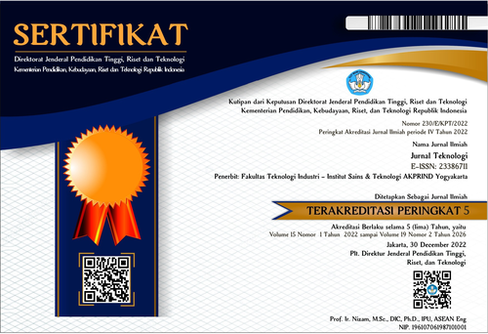Analisis Pengaruh Mobilitas Penduduk terhadap Kasus Covid-19 Selama Masa Pandemi di Indonesia Menggunakan Regresi Linier Berganda
DOI:
https://doi.org/10.34151/jurtek.v14i2.3636Keywords:
covid-19, mobility, multiple regression, pandemicAbstract
Mobility of population is closely related and is thought to have an effect on the number of COVID-19 cases. From time to time, the movement of people's mobility is mapped geographically in various categories, namely retail and recreation, grocery stores and pharmacies, parks, public transportation centers, workplaces, and residential areas. Population mobility is very closely related and is thought to have an effect on the number of Covid-19 cases, population movements greatly affect the social interaction of the population itself, the more activities residents carry out, the more interactions are created and can cause the spread of the virus chain to increase. Therefore, population mobility can be used as a means for the government to take more efficient policies in solving the problems of the COVID-19 pandemic. This research uses the Multiple Regression method which aims to find out what categories of factors affect Covid-19 cases in Indonesia during the pandemic. The results found that the mobility category of residential areas, parks, and public transportation had a significant effect on Covid-19 cases in Indonesia during the pandemic.
Downloads
References
(2021, April 10). Retrieved from bnpb-inacovid19.hub.arcgis.com: https://bnpb-inacovid19.hub.arcgis.com/datasets/inacovid19::data-harian-kasus-per-provinsi-covid-19-indonesia/about
Barokah, T. (2017). Analisis Regresi Berganda. repository.unimus.ac.id.
Ghiffari, R. A. (2020). Dampak Populasi Dan Mobilitas Perkotaan Terhadap Penyebaran Pandemi Covid-19 Di Jakarta. Tunas Geografi 9(1), 81.
Ghozali, I. (2009). Aplikasi Analisis Multivariate dengan Program SPSS. Semarang: Badan Penerbit UNDIP.
Google. (2021, April 10). Retrieved from Google.com: https://www.google.com/covid19/mobility/index.html?hl=id
Halimi, U. (2014). Regresi Linier dengan Metode Kuadrat Terkecil. Seri Matematika Terapan untuk S2, 20.
Hidayat, A. (2017, juni 4). Penjelasan Berbagai Jenis Regresi Berganda. Retrieved from statistikian.com: https://www.statistikian.com/2017/06/berbagai-jenis-regresi-berganda.html
Mukaromah, V. F. (2020). Melihat Peningkatan Kasus Covid-19 di Indonesia dari Bulan ke Bulan. Jakarta: Kompas.
Ningsih , S., & Dukalang, H. (2019). Penerapan Metode Suksesif Interval pada Analisis Regresi Linier Berganda. Jambura Journal of Mathematics Vol. 1, No. 1, 43-53.
Punggodewi, P., & Pratiwi, N. (2020). Pemodelan Faktor-Faktor yang Mempengaruhi Indeks Ketahanan Pangan dengan Menggunakan Pendekatan Multivarite Adaptive Regression Spilne (MARS). Jurnal Statistika Industri dan Komputasi, 93-106.
Quraisy, A. (2020). Normalitas Data Menggunakan Uji Kolmogorov-Smirnov dan Shapiro-Wilk. J-HEST: Journal of Health, Education, Economics, Science, and Technology, 3.
Sulistyono, & Sulistiyowati, W. (2017). Peramalan produksi dengan metode regresi linier berganda. Prozima, 82-89.
Supriyadi, E., Mariani, S., & Sugiman. (2017). Perbandingan Metode Partial Least Square (PLS) dan Principal Component Regression (PCR) untuk Mengatasi Multikolinearitas pada Model Regresi Linier Berganda. UNNES Journal of Mathematics (UJM 6(2)), 118-128.
Tjiptoherijanto, P. (2000). Mobilitas Penduduk dan Pembangunan Ekonomi. Makalah disampaikan dalam Simposium Dua Hari Kantor Menteri Negara Transmigrasi dan Kependudukan/BAKMP, Jakarta, 25-26.
Walpole, R. E., & Myers, R. H. (2011). Probability & Statistics for Engineers & Scientists 9th Ed. USA: Pearson.
Winarjono, A. (2010). Analisis Statistika Multivariat Terapan. Yogyakarta: UPP STIM YKPN.
Zulkifli, & Solot, M. G. (2018). Pengaruh Customer Offline dan Customer Online Terhadap Penjualan Pada Toko 3 Second Plaza Mulia Samarinda. Jurnal Ekonomika 2580-8117 E-ISSN, 2527-6379 P-ISSN Vol.7 No.1, 44-55.
Downloads
Published
How to Cite
Issue
Section
License
Copyright (c) 2021 Zumrotul Wahidah, Dining Dwi Suci Riyani, Malecita Nur Atala Singgih, Edy Widodo

This work is licensed under a Creative Commons Attribution 4.0 International License.
Jurnal Teknologi provides immediate open access to its content in order of making research freely available to the public to support a global exchange of knowledge. All articles published in this journal are free for everyone to read and download, under licence CC BY SA.
Benefits of open access for the author, include:
- Free access for all users worldwide.
- Authors retain copyright to their work.
- Increased visibility and readership.
- No spatial constraints.




















